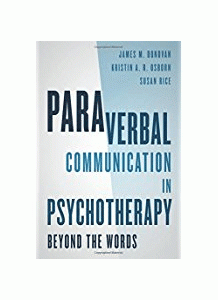Paraverbal Communication in Psychotherapy: Beyond the Words

“Paraverbal Communication in Psychotherapy: Beyond the Words.”
By James M. Donovan, Kristin A. R. Osborn and Susan Rice
Rowman & Littlefield
New York, N.Y. 2017
Book explores significance of non-verbal communication
Reviewed by Kerry Morrison, Psy.D
Paraverbal communication includes voice tones, posture, gestures, facial expression and silences. We are embodied speakers. As therapists, we’ve learned to pay attention to these key features of communication, but not all of this is on the conscious level.
This new book addresses how being attuned to not only the words that clients are saying, but how they are expressing themselves on a physical, nonverbal level is vital to change. Those therapists who are fully present, responsive and aware of the nuances of their client’s messages often have better clinical outcomes.
This ground breaking volume discusses the latest wave in psychodynamic psychotherapy. It presents a historical view of the last two decades of therapy where the field has evolved from a focus on object relations theory to relational therapy.
The authors state that relational therapy is now shifting towards an integration of preverbal, paraverbal and implicit relational knowing. Support for their theory is drawn from research on mother-infant attunement, namely publications from Stern and Beebe (1998-2005) and the work coming out of the Boston Process Study Group (2010).
The “fittedness” or paraverbal communication between mother and infant involves a “presence” (accessibility and congruence) and attunement that can lead to “moments of meeting.”
These, in turn, can develop into an implicit relational knowing. When infant and mother, as with client and therapist, are in sync, these deeply felt moments of meeting represent key junctures in therapy.
These accumulated moments when clients feel seen, heard and understood can lead to lasting change. If a client feels that the therapist is “with them” in the process, the therapy is more productive.
The authors cite a recent survey where 72 percent of therapists reported crying in session with their clients. This reaction differs greatly from the days of the therapist as a blank slate.
The book discusses how the evolution of the change in the therapy and therapists came about with the advent of videotaping therapists in-training, where not only was verbal communication on record, but the paraverbal relatedness and attunement as well.
This book is thought provoking on many levels and will likely be a valuable source for both trainees and seasoned therapists.
Kerry Morrison, Psy.D., is a psychologist for the Department of Developmental Services in the Central/West Region of Mass., who also has a private practice, consults, teaches and provides training on a range of mental health topics.
Learn more about the book: Paraverbal Communication in Psychotherapy: Beyond the Words
